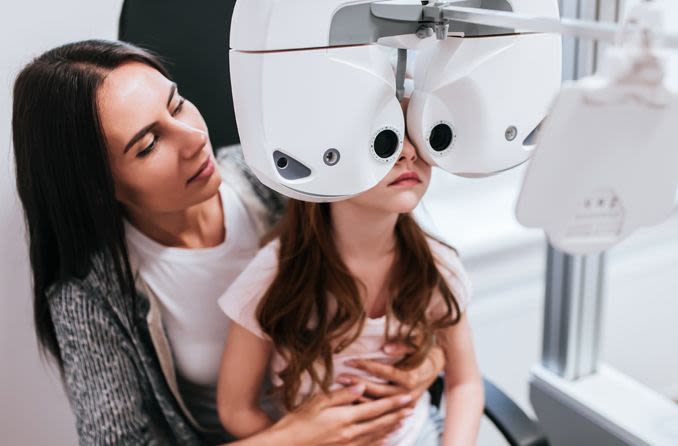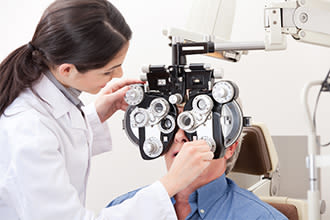Visual acuity: Is 20/20 (or 6/6) perfect vision?

If you have an eye exam and are told you have 20/20 (or 6/6) vision, does this mean you have perfect eyesight?
Is it possible to achieve even better than 20/20 vision? And what is "perfect vision" anyway?
To answer these questions, let's take a closer look at how optometrist measure the quality of your vision.
Visual acuity, eyesight and vision: What's the difference?
Visual acuity
Visual acuity is the clarity of your eyesight, measured by your ability to identify letters or numbers on a standardised eye chart from a specific viewing distance.
Visual acuity is a static measurement, meaning you are sitting still during the testing and the letters or numbers you are viewing also are stationary.
Visual acuity also is tested under high contrast conditions — typically, the letters or numbers on the eye chart are black, and the background of the chart is white.
Although visual acuity testing is very useful to determine the relative clarity of your eyesight in standardised conditions, it isn't predictive of the quality of your vision in all situations.
For example, it can't predict how well you would see:
Objects that are similar in brightness to their background
Coloured objects
Moving objects
Three major physical and neurological factors determine visual acuity:
How accurately the cornea and lens of the eye focus light onto the retina
The sensitivity of the nerves in the retina and vision centres in the brain
The ability of the brain to interpret information received from the eyes
Only light that is focused on a very small and highly sensitive portion of the central retina (called the macula) influences visual acuity measurements obtained during an eye exam.
FIND AN OPTOMETRIST: if you're worried about your vision, visit an optometrist near you.
Visual acuity typically is quantified with Snellen fractions (see "What is 20/20 (6/6) Vision?" below).
Eyesight
The exact definition of "eyesight" is difficult to pin down. Depending on which dictionary or other resource you check, it can mean "ability to see," "the sense of seeing," "vision," "range of sight" or "view." Often, the terms "eyesight" and "visual acuity" are used interchangeably.
Vision
Vision is a broader term than visual acuity or eyesight. In addition to clarity of sight or simply a description of the ability to see, the term "vision" all interactions between the eyes and the brain, and all neurological processes that take place in the brain to make the sense of vision possible.
Also, unlike simple eyesight or Snellen (high contrast) visual acuity, measures of vision include contrast sensitivity, the ability to track moving objects with smooth and accurate eye movements, colour vision, depth perception, focusing speed and accuracy, and more.
Because of the broader nature of the word “vision,” what is commonly called “20/20 (6/6) vision" should really be called "20/20 (6/6) visual acuity" or “20/20 (6/6) eyesight.”
What is 20/20 or 6/6?
The term "20/20" (or 6/6 when measured in metres as used in Australia and New Zealand) and similar fractions (such as 20/60 (6/18), 20/40 (6/12) etc.) are visual acuity measurements. They also are called Snellen fractions, named after Herman Snellen, the Dutch ophthalmologist who developed this eyesight measurement system in 1862.
In the Snellen visual acuity system, the top number of the Snellen fraction is the viewing distance between the patient and the eye chart. In the United States, this distance typically is 20 feet; in ANZ it is 6 metres (therefore 20/20 is equal to 6/6).
At this testing distance, the size of the letters on one of the smaller lines near the bottom of the eye chart has been standardised to correspond to "normal" visual acuity — this is the "20/20 (6/6)" line. If you can identify the letters on this line but none smaller, you have normal 20/20 (6/6) visual acuity.
The increasingly larger letter sizes on the lines on the Snellen chart above the 20/20 (6/6) line correspond to worse visual acuity measurements (20/30 (6/9); 20/50 (6/12) ; etc.); the lines with smaller letters below the 6/6 line on the chart correspond to visual acuity measurements that are even better than 20/20 vision (e.g. 6/5; 6/3).
The single big "E" at the top of most Snellen eye charts corresponds to 20/200 (6/60) visual acuity. If this is the smallest letter size you can discern with your best corrective lenses in front of your eyes, you are considered legally blind.
On most Snellen charts, the smallest letters correspond to 20/10 (6/3) visual acuity. If you have 20/10 (6/3) visual acuity, your eyesight is twice as sharp as that of a person with normal (20/20) vision.
Is it possible to see better than 20/20 (6/6)?
Yes, it's indeed possible to have sharper than 20/20 (6/6) visual acuity. In fact, most people with young, healthy eyes are capable of identifying at least some of the letters on the 20/15 (6/5 in ANZ) line or even smaller letters on the Snellen chart.

Your optometrist or an assistant will use an instrument to show you choices of lenses to sharpen your eyesight.
This may be due in part to better printing methods available today vs. those in the 19th century when Snellen was determining the smallest letters a person with “normal vision” should be able to discern.
A good case could be made that "normal" visual acuity today is an ability to identify letters that are a bit smaller than those on the 20/20 (6/6) line of a traditional Snellen eye chart.
If your current vision is 20/20 (6/6), is there anything that can make your eyesight clearer?
In some cases, if your best visual acuity is 20/20 (6/6) with glasses, it may be possible for you to see more clearly than 20/20 (6/6) with gas permeable (GP) contact lenses. This is because GP lenses can correct higher-order aberrations that cannot be corrected with standard glasses.
Another option might be custom wavefront LASIK. This personalised laser vision correction surgery can provide vision that is comparable to wearing rigid gas permeable contact lenses (which often is sharper than the visual acuity provided by glasses or soft contact lenses), without the hassle of the daily contact lens care.
See an optometrist
To see as clearly and comfortably as possible, see an optometrist for a comprehensive eye exam and discuss the best possible vision correction options for your specific needs.
If you are interested in finding out if laser vision correction could give you better visual acuity than glasses or contacts, ask to be referred to a LASIK surgeon for a consultation.
Page published on Tuesday, 17 March 2020






